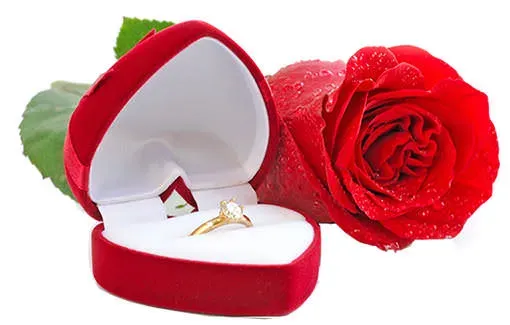 February 14th is Valentine's Day, a wonderful time to show how much you care for the people in your life. Nothing says "I love you"" as clearly as jewelry, and showering your beloved with heart-shaped stones or something delicate in 14 karat gold is easy at Jewels For Me, where we offer rings, earrings, bracelets and pendants in your choice of color and classic style. Valentine's Day has also become a time to show your appreciation for friends, family, classmates and coworkers; we have simple designs that can work for them, and rings to surprise the men in your life as well. After all the flowers and candy are gone, jewelry keeps its luster and tells the story of how you care."
February 14th is Valentine's Day, a wonderful time to show how much you care for the people in your life. Nothing says "I love you"" as clearly as jewelry, and showering your beloved with heart-shaped stones or something delicate in 14 karat gold is easy at Jewels For Me, where we offer rings, earrings, bracelets and pendants in your choice of color and classic style. Valentine's Day has also become a time to show your appreciation for friends, family, classmates and coworkers; we have simple designs that can work for them, and rings to surprise the men in your life as well. After all the flowers and candy are gone, jewelry keeps its luster and tells the story of how you care."
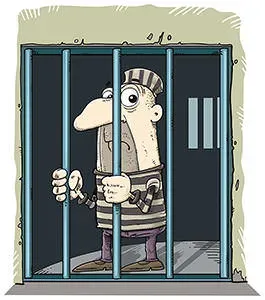 Though Valentine's Day now embodies all of our culture's romantic possibility, it began in a far less glamorous context: the prisons of third century Rome. The Emperor Claudius II had outlawed marriage for young men in order to build a bigger, better army, but a priest named Valentine defied the decree and continued to wed young couples. For this and for his efforts to help Christians escape from harsh Roman prisons, Valentine himself was imprisoned. The jailor's daughter, a blind girl, brought him food and delivered messages to and from his cell. Before he was put to death in 270 A.D., Valentine sent her a note of appreciation signed, "From your Valentine,"" an expression which persists today."
Though Valentine's Day now embodies all of our culture's romantic possibility, it began in a far less glamorous context: the prisons of third century Rome. The Emperor Claudius II had outlawed marriage for young men in order to build a bigger, better army, but a priest named Valentine defied the decree and continued to wed young couples. For this and for his efforts to help Christians escape from harsh Roman prisons, Valentine himself was imprisoned. The jailor's daughter, a blind girl, brought him food and delivered messages to and from his cell. Before he was put to death in 270 A.D., Valentine sent her a note of appreciation signed, "From your Valentine,"" an expression which persists today."
 At the time, pagan Romans celebrated a feast called Lupercalia to honor the God Lupercus, who was said to watch over the shepherds and keep them safe from wolves. The feast took place in February, which was the official beginning of spring and a time for purification. Houses were cleansed and Roman priests known as the Luperci gathered at a sacred cave where the mythical twins Romulus and Remus ï¾– founders of Rome ï¾– were said to have been suckled by a she-wolf. The priests sacrificed a goat for fertility and a dog for purification, then took strips of the goat's hide and gently touched them to the fields of crops and local women to enhance their fertility in the coming year. Later in the day, young women placed their name in an urn and the city's bachelors chose a name at random which paired them with the woman they selected for the following year and sometimes led to marriage.
At the time, pagan Romans celebrated a feast called Lupercalia to honor the God Lupercus, who was said to watch over the shepherds and keep them safe from wolves. The feast took place in February, which was the official beginning of spring and a time for purification. Houses were cleansed and Roman priests known as the Luperci gathered at a sacred cave where the mythical twins Romulus and Remus ï¾– founders of Rome ï¾– were said to have been suckled by a she-wolf. The priests sacrificed a goat for fertility and a dog for purification, then took strips of the goat's hide and gently touched them to the fields of crops and local women to enhance their fertility in the coming year. Later in the day, young women placed their name in an urn and the city's bachelors chose a name at random which paired them with the woman they selected for the following year and sometimes led to marriage.
 Around 498 A.D., Pope Gelasius outlawed this "lottery"" system of romantic pairing and declared May 3rd the honorary feast day to honor St. Valentine, the patron saint of lovers. Over the next thousand years, love lotteries persisted, however, and in England during the Middle Ages, men wore the name of the girl whose name they drew written on their sleeve and encircled with a heart."
Around 498 A.D., Pope Gelasius outlawed this "lottery"" system of romantic pairing and declared May 3rd the honorary feast day to honor St. Valentine, the patron saint of lovers. Over the next thousand years, love lotteries persisted, however, and in England during the Middle Ages, men wore the name of the girl whose name they drew written on their sleeve and encircled with a heart."
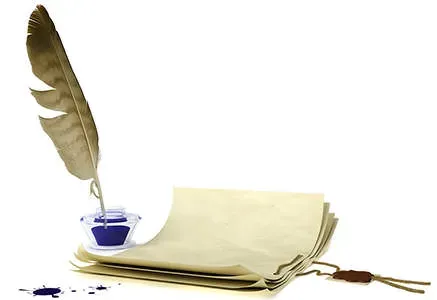 The earliest known Valentine gifts are poems composed to be read or sung for the courts of 14th century England and France. In 1381, Geoffrey Chaucer was commissioned to write a poem in honor of the arranged marriage between England's Richard II and Anne of Bohemia. Richard II had signed his engagement papers on May 3rd, and when Chaucer learned that that day was St. Valentine's feast day, he wrote the dreamy poem Parliament of Fowls, in which Saint Valentine's Day is the occasion for "every fowlï¾… to choose his mate. After Chaucer's death in 1400, Valentine's Day celebrations got pushed back to February."
The earliest known Valentine gifts are poems composed to be read or sung for the courts of 14th century England and France. In 1381, Geoffrey Chaucer was commissioned to write a poem in honor of the arranged marriage between England's Richard II and Anne of Bohemia. Richard II had signed his engagement papers on May 3rd, and when Chaucer learned that that day was St. Valentine's feast day, he wrote the dreamy poem Parliament of Fowls, in which Saint Valentine's Day is the occasion for "every fowlï¾… to choose his mate. After Chaucer's death in 1400, Valentine's Day celebrations got pushed back to February."
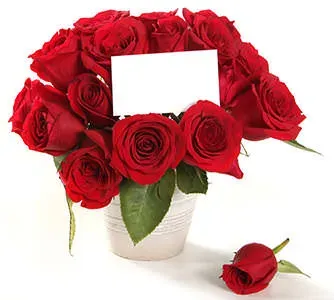 By the 15th century, written Valentine cards were finally in vogue, and by the 17th century, it had become customary to present a gift along with them. Such gifts ranged from quaint love knots braided out of straw to the opulent jewelry showered upon ladies at court. The 17th century was a grand time for love: in 1632, Emperor Shah Jahan began building the Taj Mahal, commissioned for his favorite wife, Arjumand Bano Begum, who is better known as Mumtaz. Those who couldn't afford architecture gave flowers instead. The Persian poetical art known as "the language of flowers"" moved to Europe in the early 1700s and throughout the 18th century, floral lexicons were published, explaining the meaning of each bloom. Lovers exchanged secrets through metaphors embodied by flowers. Today, while we've lost the precise significance of the lily or the tulip, every girl knows what it means to receive a red rose, and guys have gotten pretty clever about attaching cards to stems and hiding presents in the fronds of ferns."
By the 15th century, written Valentine cards were finally in vogue, and by the 17th century, it had become customary to present a gift along with them. Such gifts ranged from quaint love knots braided out of straw to the opulent jewelry showered upon ladies at court. The 17th century was a grand time for love: in 1632, Emperor Shah Jahan began building the Taj Mahal, commissioned for his favorite wife, Arjumand Bano Begum, who is better known as Mumtaz. Those who couldn't afford architecture gave flowers instead. The Persian poetical art known as "the language of flowers"" moved to Europe in the early 1700s and throughout the 18th century, floral lexicons were published, explaining the meaning of each bloom. Lovers exchanged secrets through metaphors embodied by flowers. Today, while we've lost the precise significance of the lily or the tulip, every girl knows what it means to receive a red rose, and guys have gotten pretty clever about attaching cards to stems and hiding presents in the fronds of ferns."
 Americans began exchanging hand-made Valentines in the early 1700s. These were paper cards with sentimental verses written on them. It got easier to write to your sweetheart in 1723, when America began importing Valentine "writers"" from England ï¾– booklets containing verses and messages that could be copied onto gilt-edged letter paper and given away. The ""writers"" also contained responses for the women to use to approve or reject their suitors. By the end of the century, printed cards began to replace written letters due to improvements in printing technology. Ready-made cards were a great way for people to express themselves at a time when direct expression of emotions was discouraged."
Americans began exchanging hand-made Valentines in the early 1700s. These were paper cards with sentimental verses written on them. It got easier to write to your sweetheart in 1723, when America began importing Valentine "writers"" from England ï¾– booklets containing verses and messages that could be copied onto gilt-edged letter paper and given away. The ""writers"" also contained responses for the women to use to approve or reject their suitors. By the end of the century, printed cards began to replace written letters due to improvements in printing technology. Ready-made cards were a great way for people to express themselves at a time when direct expression of emotions was discouraged."
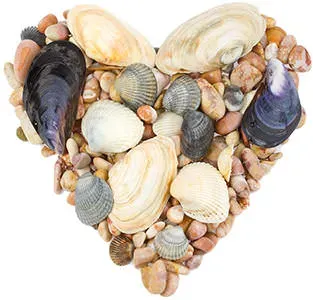 Valentines became especially popular in the US during the 19th century. Lonely Victorian sailors used seashells of various sizes to create hearts, flowers and other designs to send to their girlfriends back home. In the 1840s, Esther Howland began selling the first mass-produced Valentines in America. Her cards were elaborate creations using real lace, ribbons and colorful pictures of pink-cheeked cherubs nestled in pillows and clouds. Some Valentines of the period were so thick with embellishments that they came in presentation boxes rather than envelopes. They unfolded like fans or mechanically operated using levers or disks that made figures dance and birds flutter their wings. Occasionally semiprecious stones and jewels were used in the composition of the Valentine as well. Many of these extraordinary cards were glued into scrapbooks, which became popular after the Civil War. The lyrics in these cards were as romantic as their decorations and it was during this period (1850), that Elizabeth Barrett Browning penned Valentine's Day's most oft-quoted phrase for her husband, Robert: "How do I love thee? Let me count the ways."""
Valentines became especially popular in the US during the 19th century. Lonely Victorian sailors used seashells of various sizes to create hearts, flowers and other designs to send to their girlfriends back home. In the 1840s, Esther Howland began selling the first mass-produced Valentines in America. Her cards were elaborate creations using real lace, ribbons and colorful pictures of pink-cheeked cherubs nestled in pillows and clouds. Some Valentines of the period were so thick with embellishments that they came in presentation boxes rather than envelopes. They unfolded like fans or mechanically operated using levers or disks that made figures dance and birds flutter their wings. Occasionally semiprecious stones and jewels were used in the composition of the Valentine as well. Many of these extraordinary cards were glued into scrapbooks, which became popular after the Civil War. The lyrics in these cards were as romantic as their decorations and it was during this period (1850), that Elizabeth Barrett Browning penned Valentine's Day's most oft-quoted phrase for her husband, Robert: "How do I love thee? Let me count the ways."""
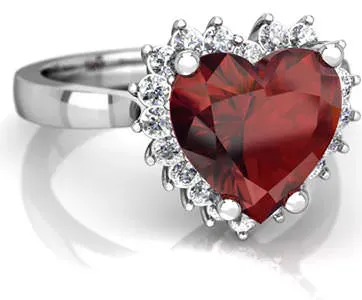 On the advent of World War I, Valentine cards began to become less elaborate, mostly because styles were leaning towards "less is more"" during tough war times. Even after the war, styles in America and abroad had become much lighter and Valentines became slicker and more efficiently produced. It became popular to give them away in schools and to all members of your family. Valentine's Day was stuck so firmly in our popular consciousness that even when Pope Paul VI dropped the holiday from the Christian calendar in 1969, we all continued to celebrate February 14th as a day of love. In addition to the United States, Valentine's Day is celebrated in Canada, Mexico, the United Kingdom, France, and Australia. Today, it's a time to pick out something special for your loved ones, something personalized and unique. At Jewels For Me, our handcrafted jewelry is tenderly made and the perfect choice for Valentine's Day."
On the advent of World War I, Valentine cards began to become less elaborate, mostly because styles were leaning towards "less is more"" during tough war times. Even after the war, styles in America and abroad had become much lighter and Valentines became slicker and more efficiently produced. It became popular to give them away in schools and to all members of your family. Valentine's Day was stuck so firmly in our popular consciousness that even when Pope Paul VI dropped the holiday from the Christian calendar in 1969, we all continued to celebrate February 14th as a day of love. In addition to the United States, Valentine's Day is celebrated in Canada, Mexico, the United Kingdom, France, and Australia. Today, it's a time to pick out something special for your loved ones, something personalized and unique. At Jewels For Me, our handcrafted jewelry is tenderly made and the perfect choice for Valentine's Day."